
In this Article, I share examples of grade conversion charts to convert your grades to MEXT’s 3.0 GPA system, which was originally printed in the appendix of my book, How to Win the MEXT Scholarship.

Before converting your grades using the chart below, please read my article about “How to Calculate your GPA for the MEXT Scholarship“. That article explains the process and calculation details. Here, I only share the charts.
If you cannot find a match for your grading system in the examples below, and you would like me to add yours, please submit a scan of your Explanation of the Grading System (see the examples below) via the form below, and I will add it: https://mymext.com/submitgrades
Note: I do not need to see your actual grades or any personal information. Please only submit an image of the system explanation!
Grade “Buckets”
In the descriptions that follow, I use the term “grade bucket” to mean a group of grades that all have the same converted value. For example, the grades “A+”, “A”, and “A-” might be considered one grade bucket. Or the a score range of “100 – 80” might be a single grade bucket.
When you convert your grades, you will need to determine how many buckets your system has and which grades correspond to each bucket. Typically, you should have 4 or 5 buckets. Multiple grades may fit into each of those buckets, as we will show in the examples below.
In some cases, you may encounter a system with only three buckets (e.g. distinction, pass, fail), but these are quite rare. I will explain that system below as well. For systems with more than 5 apparent buckets, like ECTS grades with 6, we will squeeze them into 5, using the charts that follow.
There are a few complications you may run into in assigning your grades to different buckets are subgrades or the average marks system.
For subgrades, such as +/- or combined grades like A/B, refer to the explanation of the grading system from your university. If your grading system does not explain the subgrades, you can probably ignore the “+” and “-“, but if you want a more conservative estimate, treat “-” grades as the next lower bucket.
Note: Grades followed by a 0, such as A0, B0, etc., are not subgrades. Treat them as being the same as an A or B, respectively.
Grading System Conversions
Letter Grade Systems
Letter grade systems, typically A through E or F, are common in many countries, including the US, most of Europe (ECTS), many universities in East and Southeast Asia, and of course, Japan. However, there are several different ways of interpreting the relative value of these grades. Typically, Japanese universities will interpret the grades according to their own understanding, unless you have a grading scale to show them otherwise.
Letter grades can have pluses (e.g. A+), minuses (e.g. A-), zeroes (e.g. A0), or combined letters (e.g. A/B), which complicate the interpretation. I will include as many examples as possible below.
MEXT offers two official examples of how to convert letter grades to its 3.0 scale: A 4-bucket system and a 5-bucket system.
Letter Grades: 4 Letters (ABCF), Official
| Grading System: ABCF (Official) | ||||
|---|---|---|---|---|
| Local Grade | A | B | C | F |
| MEXT Grade | 3 | 2 | 1 | 0 |
| Used in: Example from official MEXT guidelines, Taiwan (Grad School), Pakistan (Grad School) | ||||
This is the official example from MEXT, but I have only ever seen it used for graduate programs. For graduate programs, a “C” is typically considered the minimum passing grade and expectations are higher in general.
Leniency for Grad School Conversions?
For graduate school, you could also make the argument that an ABCF scale should be considered to be the same as an ABCDF scale (as shown below) where there is just no “D” (or “1” on the MEXT system) possible. If you compare the undergraduate and graduate grading scales in the example below, you’ll see the GPA equivalents for A, B, and C are the same as the corresponding undergrad grades. It might be worth giving it a shot!
Here is an example of a grading system showing this scale, for graduate school grades.

Of course, citizens of Taiwan are not eligible to apply for the MEXT scholarship, but international students who graduate from Taiwanese universities would be eligible.
Letter Grades: 4 Letters (ABCF), with Quality Variation
This is a variation on the 4-letter system that has plusses and minuses. In most cases, you should ignore the plus or minus and consider the grade to be same as the plain letter, but in the case below, the quality descriptions place “B+” in a higher category.
| Grading System: ABCF (With +/- and Quality Variation) | ||||
|---|---|---|---|---|
| Local Grade | A+, A, A-, B+ | B, B- | C+, C | F |
| MEXT Grade | 3 | 2 | 1 | 0 |
| Used in: India | ||||
Here is the grading system example that resulted in the chart above:

Letter Grades: 5 Letters (ABCDF, etc.), Official
MEXT offers two official 5-bucket letter grade conversion scales, but I have never seen the first one used:
| Grading System: Official: SABCF | |||||
|---|---|---|---|---|---|
| Local Grade | S | A | B | C | F |
| MEXT Grade | 3 | 3 | 2 | 1 | 0 |
| Used in: Example from official MEXT guidelines | |||||
The one I do see more commonly is:
| Grading System: Official: ABCDF | |||||
|---|---|---|---|---|---|
| Local Grade | A | B | C | D | F |
| MEXT Grade | 3 | 3 | 2 | 1 | 0 |
| Used in: Example from official MEXT guidelines, Taiwan | |||||
Most often, you will see this system with pluses and minuses, as in the example below.
Letter Grades: 5 Letters, with Plus/Minus
The rest of the letter grade conversion tables are not official. These are based on examples and methods that I have personally used, but in some places they may be up for interpretation.
Five letter systems with pluses and minuses are, by far, the most common system I see. There are several different variations on the system. Some universities may use only pluses and no minuses. Some may specify a non-plus/minus grade with a zero (such as “A0”) to make it impossible to forge into a plus later. Some may use “E” for a failing grade and some may use “F”.
I will list all of the most common variants in the table below, but keep in mind that not all of the grades listed in each bucket may apply to you, as you will be able to see from the example images below. That is not a problem.
There are a few important exceptions to this chart, regarding minuses, that we will cover below.
| Grading System: ABCDF (with +/-) | |||||
|---|---|---|---|---|---|
| Local Grade | A+, A, A- | B+, B, B- | C+, C, C- | D+, D, D- | E or F |
| MEXT Grade | 3 | 3 | 2 | 1 | 0 |
| Used in: Brunei, Canada, Hong Kong, Korea, Macau, Malaysia, Singapore, Thailand, USA | |||||
Examples:



Letter Grades: 5 Letters, with Plus/Minus – Variations
I mentioned above that there are some exceptions to the chart above. The most dangerous one is grading systems that specify that a minus grade should be considered to be grouped with the next lower letter grade. As you can imagine, this can have a significant effect on your overall GPA calculation.
Heres’ what the conversion chart would look like:
| Grading System: ABCDF (drop -) | |||||
|---|---|---|---|---|---|
| Local Grade | A+, A | A-, B+, B | B-, C+, C | C-, D+, D | F |
| MEXT Grade | 3 | 3 | 2 | 1 | 0 |
| Used in: Morocco | |||||
And here’s an example of they grading system explanation that would result in the chart above:
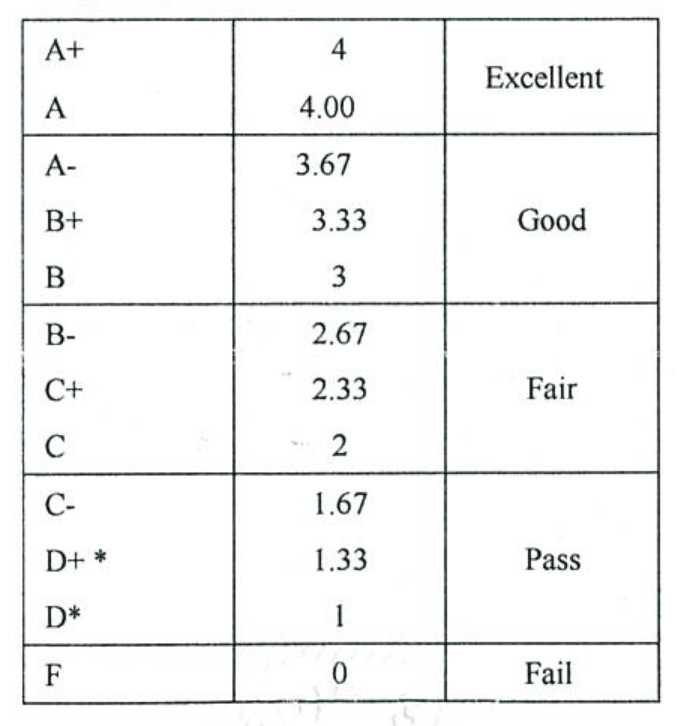
It is also possible that only some minuses would be dropped, like the example below, where a C- is dropped to be a failing grade.
| Grading System: Malaya Grades | |||||
|---|---|---|---|---|---|
| Local Grade | A+ | A, A- | B+, B, B- | C+, C | C-, D+, D, F |
| MEXT Grade | 3 | 3 | 2 | 1 | 0 |
| Used in: Malaysia | |||||
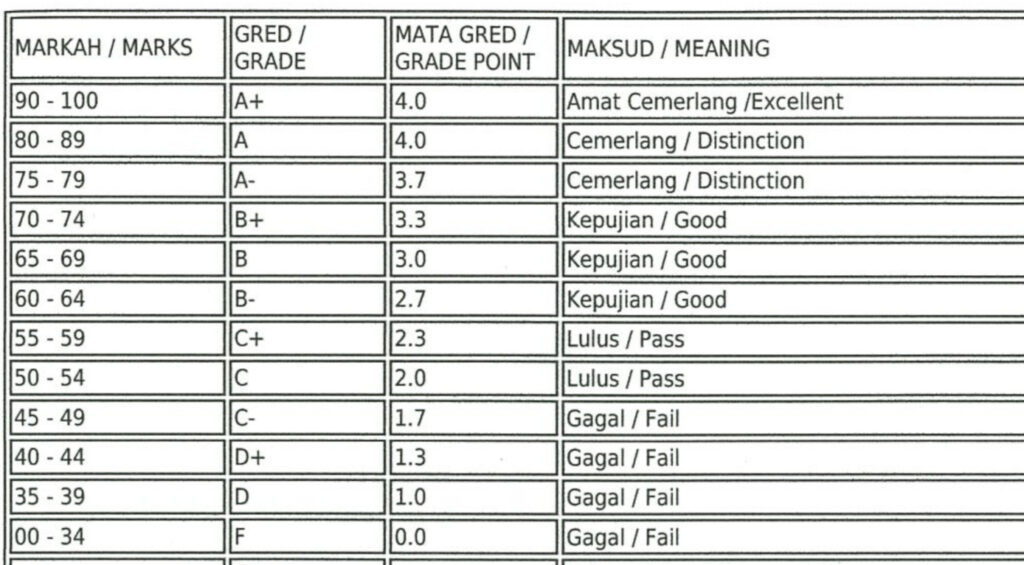
Finally, in some cases, instead of a “+” or “-“, the university may combine both letters, as in the case below:
| Grading System: ABCDE (with “AB”) | |||||
|---|---|---|---|---|---|
| Local Grade | A | AB, B | BC, C | D | E |
| MEXT Grade | 3 | 3 | 2 | 1 | 0 |
| Used in: Indonesia | |||||
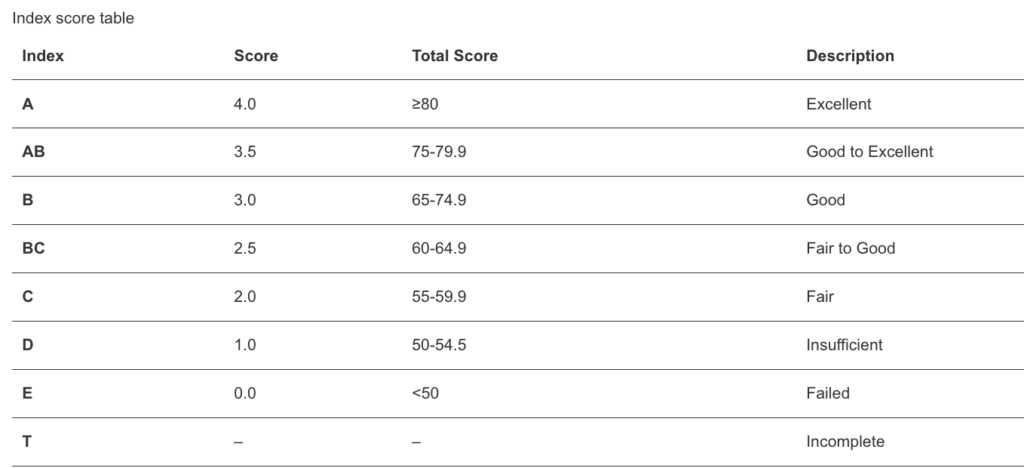
Letter Grades: 3 or 4 Letters, with Plus/Minus
While not as common as 5-letter grading systems, you may find some 4-letter grading systems with pluses and minuses, which would be evaluated as below:
| Grading System: ABCDEF with Specified Pass Cut-Off | ||||
|---|---|---|---|---|
| Local Grade | A+, A, A- | B+, B, B- | C+, C, C- | D, E, F |
| MEXT Grade | 3 | 2 | 1 | 0 |
| Used in: New Zealand, Taiwan | ||||
Example:

Letter Grades: ECTS
ECTS, the common standard in Europe, is a 6-bucket system and, in general grades earned under the ECTS system are “harsher” than those under the US or Japanese systems. For example, World Education Services (WES), an internationally recognized company that maintains conversion tables from almost all countries’ systems to the US 4.0 system, converts an ECTS “C” to an American “B” for GPA purposes (3.0 out of 4.0 in the US, which is 3.0 out of 3.0 on the MEXT Scale).
If you are a European applying via the Embassy-Recommended MEXT Scholarship, you do not need to worry, since all other applicants will have been graded on the same system and the embassy should be familiar with it.
However, if you completed your degree at a European university but are applying for Embassy-Recommended MEXT Scholarship in another country, or if you are applying for University-Recommended MEXT Scholarship, the reviewers might not realize that ECTS grades are stricter than other countries’ letter grades. In that case, it might be in your interest to include an official chart from your university that shows the equivalency between ECTS and US letter grades, for example. Ask your university’s study abroad or admissions office if they have something like that you can reference! If your grading system also has quality descriptions, as in the first example below, that would work fine, too.
Here are two ways to interpret ECTS letter grades. The first is how I would do it, based on my experience working with hundreds of students from across Europe. The second, strict, model is how someone who did not understand ECTS might interpret your grades. If you want to be strict on yourself, for the sake of making sure that you meet the eligibility criteria, use the second scale. Remember, your conversion is not official, anyway, so you can not hurt yourself be being harsh.
ECTS Scale 1:
| Grading System: ECTS | |||||
|---|---|---|---|---|---|
| Local Grade | A, B | C | D | E | Fx, F |
| MEXT Grade | 3 | 3 | 2 | 1 | 0 |
| Used in: Europe | |||||
ECTS Scale 2 (Strict):
| Grading System: ECTS (Strict) | |||||
|---|---|---|---|---|---|
| Local Grade | A | B | C | D, E | Fx, F |
| MEXT Grade | 3 | 3 | 2 | 1 | 0 |
| Used in: Europe | |||||
Examples:
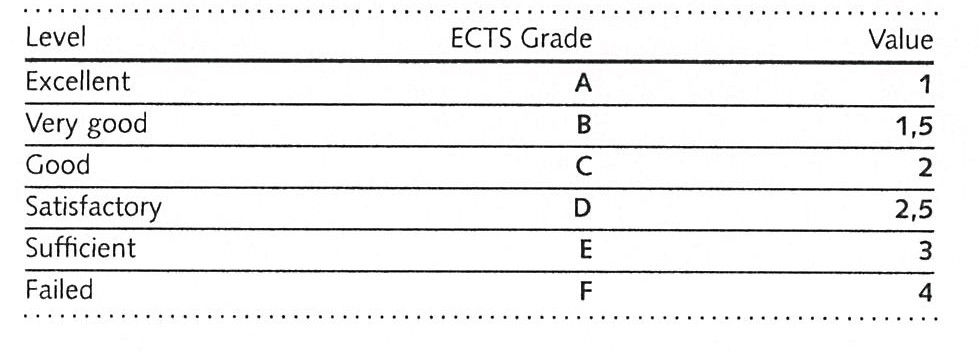
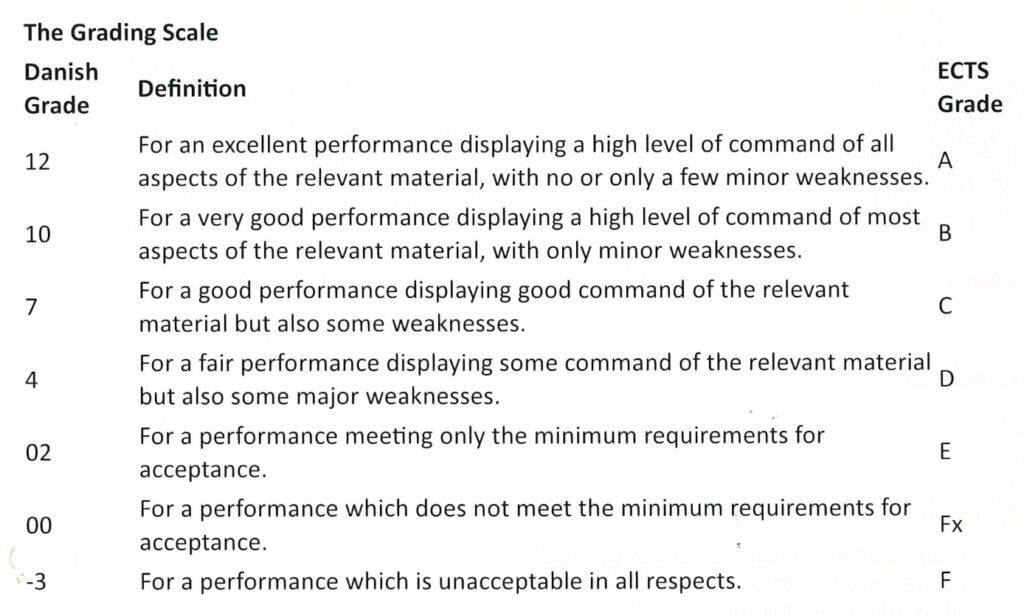
Both grading systems above clearly show that “E” is a passing grade, and “D” is “fair” or “satisfactory”, which is the same definition given to a C grade in the examples further above, so “E” should be the only 1-point value and “D” should be 2. The real question is how to treat “C”. In these examples, “C” is “Good”, as opposed to its meaning of “Average” in the US system. Therefore, it should be considered to be equivalent to a US “B” (also good) and scored at 3 points on the MEXT scale.
Percentage Scales
Like letter grades, the meaning of percentages can vary significantly from country to country. There seem to be two major philosophical outlooks on what the percentage should mean.
In countries like the US and Japan, where you tend to see high grades, the score seems to indicate what percentage of the mastery or performance expected of a student in the course you have achieved. In this system, students should be aiming for 100%.
In Europe, the UK, and countries with marks systems, the score seems to indicate instead what percentage of mastery of the subject you have achieved. In that case, even the professor might not earn 100% and for a student, earning 70% would be outstanding.
Think about your own system and the normative scores there as you read through the systems and charts below.
Percentage Grades: 4 Buckets, Official
| Grading System: Official: Percentage | ||||
|---|---|---|---|---|
| Local Grade | 100 – 80 | 79 – 70 | 69 – 60 | 59 – 0 |
| MEXT Grade | 3 | 2 | 1 | 0 |
| Used in: Example from official MEXT guidelines, Taiwan | ||||

Percentage Grades: 5 Buckets, Official
MEXT’s official standard for converting 5 percentage score buckets is based on how percentages are assigned in Japan, where 100% is achievable for students.
| Grading System: Official: Percentage | ||||
|---|---|---|---|---|
| Local Grade | 100 – 80 | 79 – 70 | 69 – 60 | 59 – 0 |
| MEXT Grade | 3 | 2 | 1 | 0 |
| Used in: Example from official MEXT guidelines, Taiwan | ||||
The example image I used for the 4-bucket system above would be a 5-range scale for undergraduates. Here is another example of what that score system might look like.

Percentage Grades: 5 Buckets, Variations
Some universities have a more “lenient” percentage scale. Although, any apparent leniency in the system is usually a reflection of how much more difficult it is to earn the corresponding grades.
| Grading System: Canada Percentage | |||||
|---|---|---|---|---|---|
| Local Grade | 100 – 80 | 79 – 70 | 69 – 60 | 59 – 50 | 49 – 0 |
| MEXT Grade | 3 | 3 | 2 | 1 | 0 |
| Used in: Canada | |||||
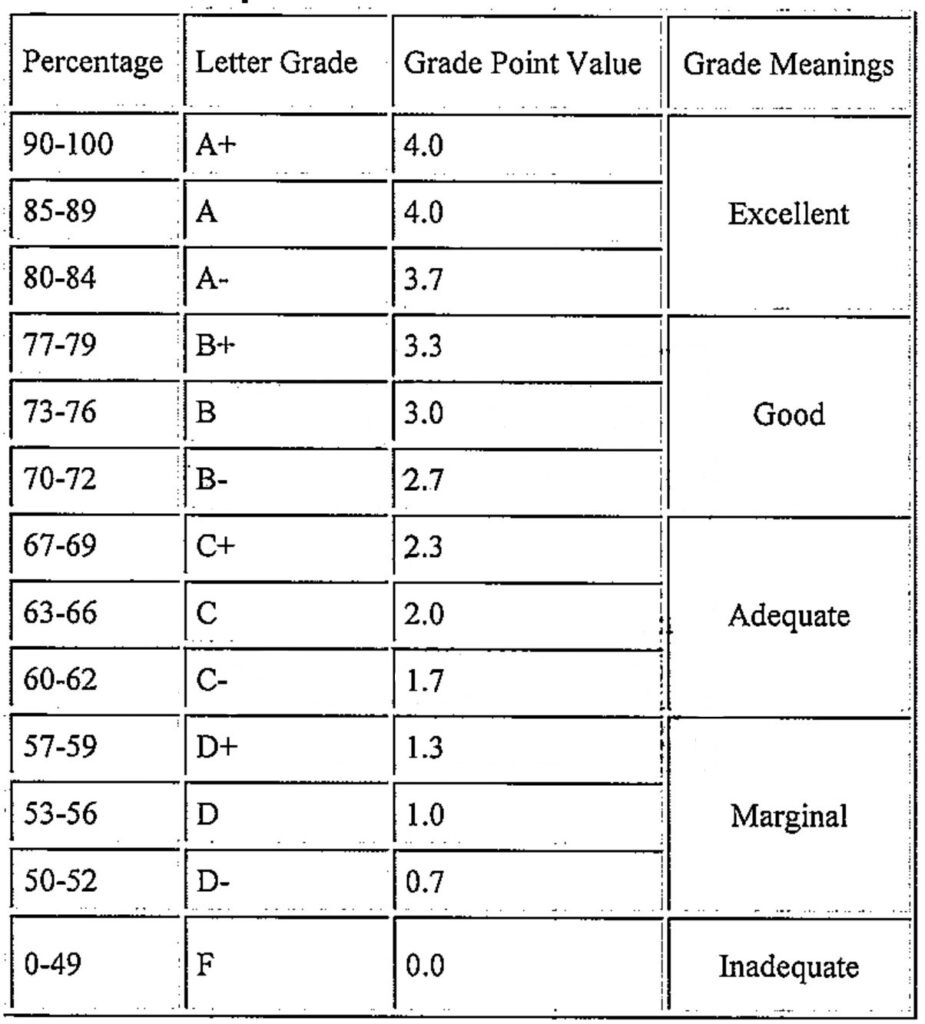
In some universities, you will find grading systems with percentage buckets, but different cut-offs, as below. In this case, use the cut-off specified in your university’s grading system!
Here is one example from the Philippines:
| Grading System: Philippines Percentage | ||||
|---|---|---|---|---|
| Local Grade | 100 – 92 | 91 – 83 | 82 – 75 | 74 – 0 |
| MEXT Grade | 3 | 2 | 1 | 0 |
| Used in: Philippines | ||||
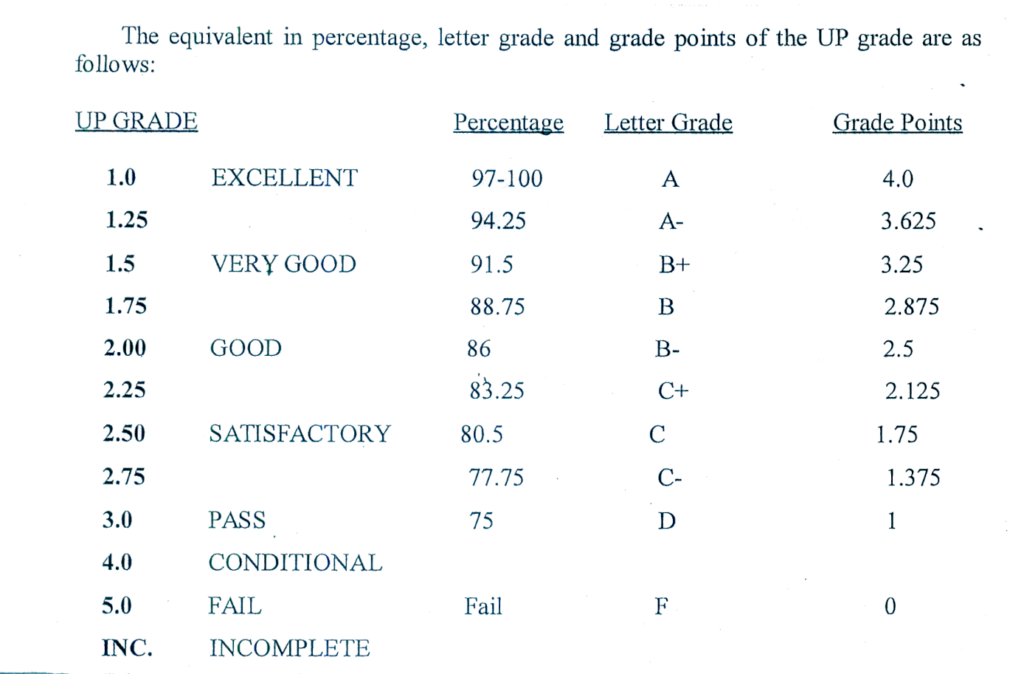
Descriptive Grades
I have found descriptive grades to be common in Commonwealth countries. In this system, the grades are stratified by a description of their quality, not immediately obvious letter or number scales. Probably the best well-known is the Honours system used in the UK, though others exist.
Descriptive Grades: 4 Buckets, Official
The system below will look familiar to you if you have completed the MEXT scholarship application form, particularly the part where you have to rate your language ability.
| Grading System: Official: Description | ||||
|---|---|---|---|---|
| Local Grade | 優 (Excellent) | 良 (Good) | 可 (pass) | 不可 (Fail) |
| MEXT Grade | 3 | 2 | 1 | 0 |
| Used in: Example from official MEXT guidelines | ||||
While this is an official conversion scale, I have never seen a university that uses it.
MEXT does not offer an official conversion scale for 5-bucket descriptive grades. However, in practice, every descriptive system I have seen had 5 buckets. Those systems would be converted just like any other 5-bucket system.
Descriptive Grades: 5-Bucket Honours
I believe all Honours grades should be converted on a 5-bucket scale. The scale below, from a UK university, shows how this could be done.
| Grading System: Honours System (with third) | |||||
|---|---|---|---|---|---|
| Local Grade | First Class | Upper Second | Lower Second | Third | Fail |
| MEXT Grade | 3 | 3 | 2 | 1 | 0 |
| Used in: UK | |||||

In Honours systems, you usually do not get an “Honours” mark for each individual course, so when converting your grades, convert each course based on how your score in that individual course would correspond to the honours ranking if that was your overall grade for your degree. For example, in the scale above, from the University of Aberdeen, students grades in each course are indicated using the marks shown in the CGS column. So, if you received a B3 in a particular course, that corresponds to an Upper Second, and so it would be a “3” on the MEXT Scale.
Another way to think of this system is that we are using the Honours titles (First Class, Upper Second, etc.) in place of the quality description (Outstanding, Good, etc.) as a frame of reference. Yes, the scale above also includes quality descriptions, but not all will!
The trouble with Honours systems is that sometimes they do not include a “Third Class” bucket. In that case, reviewers who are not familiar with the system may consider a “Lower Second” to be the minimum passing grade (i.e. “1” on the MEXT Scale), making “Upper Second” a “2”. It would be almost impossible to achieve the minimum 2.3 grade in that situation.
Descriptive Grades: Distinction
Another descriptive grading system is the Distinction system used by some universities in Australia and New Zealand. The first time I reviewed a transcript on this system, I was shocked to see that the student had earned all “C” and “D” grades. At first glance, I thought there was no way this student could be eligible, until I saw what those letters meant!
| Grading System: Distinction Marking | |||||
|---|---|---|---|---|---|
| Local Grade | HD (High Distinction), 100 – 80 | D (Distinction), 79 – 70 | C (Credit), 69 – 60 | P (Pass), 59 – 50 | N (Fail) 49 – 0 |
| MEXT Grade | 3 | 3 | 2 | 1 | 0 |
| Used in: Australia | |||||
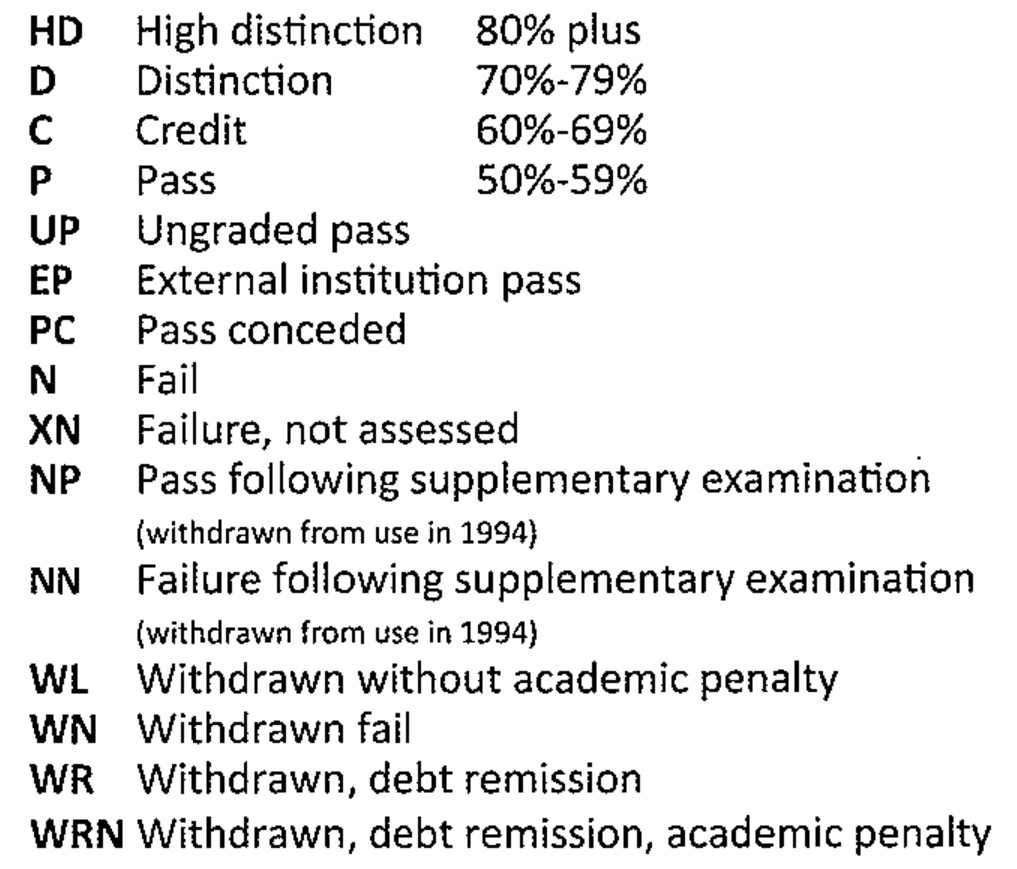
Descriptive Grades: 3 Buckets
One applicant sent me a copy of a 3-bucket descriptive grading system. These grades were from an open university, where faculty would not have much time to focus on individual students. Most students simply get a “satisfactory”, or passing, grade in each course if they do the work. Unfortunately, since that is the lowest possible passing grade, it could get converted to a 1 on the MEXT scale. Personally, I would consider it to be a “2”, since “Satisfactory” as a quality description is consistent with the description of grades in other systems that count as “2”s. But even as a “2”, this would make it essentially impossible to meet the MEXT eligibility requirements.
If your only degree program is in an open university or other university that similarly does not give much time or care to grading students, you will face significant difficulty in the application. If you are taking an open university degree program alongside a regular university’s degree program, then it may serve your interests to withdraw from or suspend your open university courses during the application period, and report that you only intend to complete your regular university degree, so that only the regular university degree will count for the GPA calculation.
| Grading System: 3-Bucket Descriptive | |||
|---|---|---|---|
| Local Grade | Honor | Satisfactory | Unsatisfactory |
| MEXT Grade | 3 | 2 | 0 |
| Used in: Open universities | |||
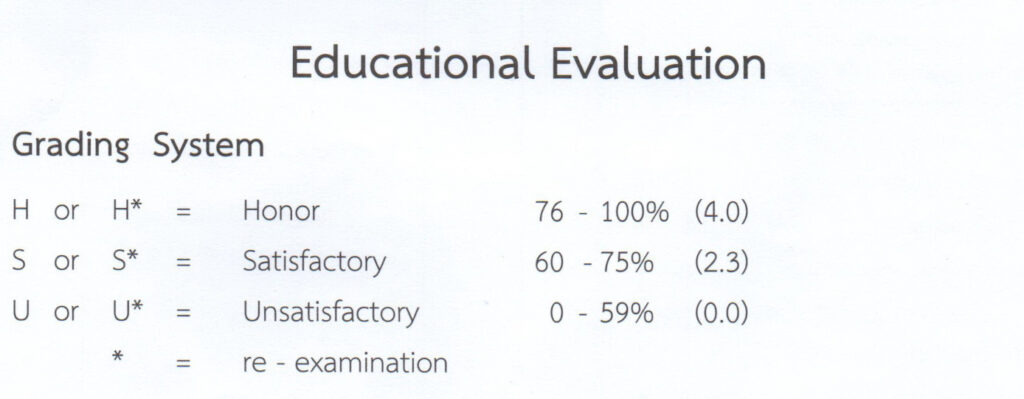
Numerical Grading Scales and GPA
While MEXT’s 3.0 GPA system is not actually used anywhere in the world that I am aware of, I have seen a number of other GPA systems or numerical grading scales.
The most common GPA scale is the 4.0 scale. I have also seen 4.3, common in Korea, 4.5 in some universities in Canada, 5.0 in Singapore and many others. However, in each of the examples above, the universities in question also had letter grades or percentage grades listed, so it was easier to convert the grades using that information. If your university has multiple grading scales including a numerical grading system and another, such as letters or percentages, I recommend that you use the letter of percentage grades to perform your conversion. Your reviewers are also likely to choose the system that they are more familiar with. Most of the examples below include multiple systems.
In this section, I will focus on universities that use numbers as their grades, to show the variety of systems. Unless you find an exact match for your grading system below, you should not assume that numbers mean the same thing in your country, but I hope this section will give you an idea of what to look for when trying to figure out how to convert number systems.
Numerical: 4-Point Inverted Scale
While a 4.0 GPA system with 4 being the best score is relatively common around the world, there are some systems where 1 is the best score, as shown below.
| Grading System: 1 (best) – 4 (worst) Scale | |||||
|---|---|---|---|---|---|
| Local Grade | 1 | 1,5 – 2 | 2,5 | 3 | 4 |
| MEXT Grade | 3 | 3 | 2 | 1 | 0 |
| Used in: Czech Republic (also uses ECTS) | |||||
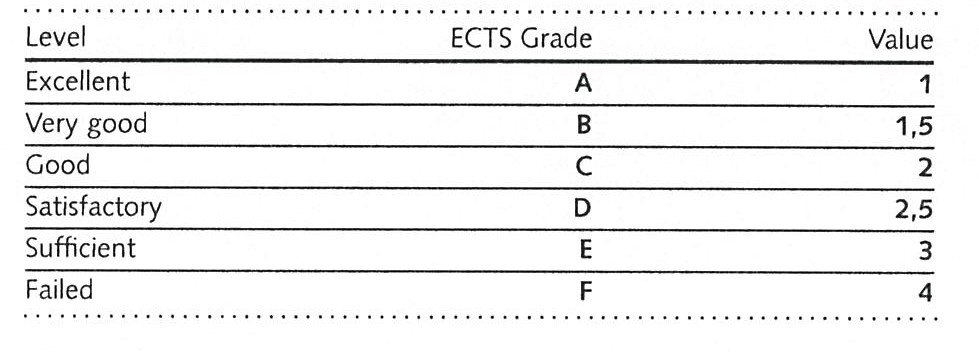
Numerical: 5-Point Scale
The Finnish example below uses a 5-point scale but has no numerical grade designated for failure, so all grades shown in numbers will have at least some value.
| Grading System: 5-Point Scale | |||||
|---|---|---|---|---|---|
| Local Grade | 5 | 4 – 3 | 2 | 1 | |
| MEXT Grade | 3 | 3 | 2 | 1 | 0 |
| Used in: Finland | |||||
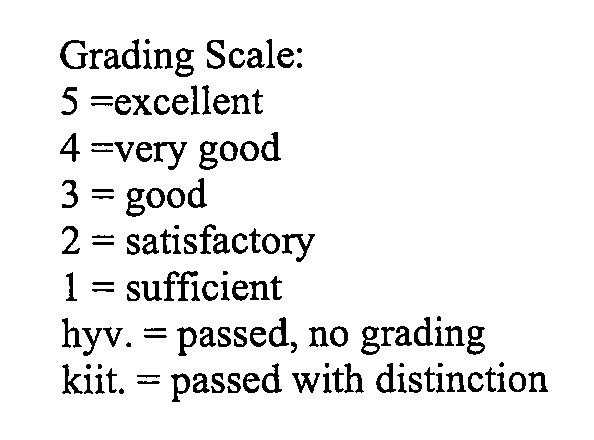
Numerical: 5-Point Inverted Scale
We used this scale earlier to highlight a different approach to percentages, but it also contains a number system. As with the percentage, The quality descriptor is the key factor for the conversion. Unlike the system above, in this case, “1” is the highest grade and “5” is a fail.
| Grading System: Philippines 5 point system | |||||
|---|---|---|---|---|---|
| Local Grade | 1.0 – 1.5 | 1.75 – 2 | 2.25 – 2.5 | 2.75 – 3.0 | 4.0 – 5.0 |
| MEXT Grade | 3 | 3 | 2 | 1 | 0 |
| Used in: Philippines | |||||

Numerical: Danish “7”-Point Scale
I have heard this scale called a seven-point scale by my colleagues in Denmark, despite the fact that the grades range from a high of 12 to a low of -3, since there are only 7 discrete grades that can be earned.
If you are in Denmark, then the range of grades may matter for calculating averages, but remember that for MEXT, we never take the average. We always convert grade-by-grade.
| Grading System: Danish 7-point Scale | |||||
|---|---|---|---|---|---|
| Local Grade | 12 – 10 | 7 | 4 | 2 | 0 – -3 |
| MEXT Grade | 3 | 3 | 2 | 1 | 0 |
| Used in: Denmark (Also uses ECTS) | |||||

Numerical/GPA: Vietnamese 10-Point GPA
Vietnamese universities grade on a 10-point GPA scale, though some also use letter grades. Although the system is referred to as a GPA scale, students are actually assigned a grade on the 10-point scale for each class. It is those individual course grades, not the overall average, that must be converted.
| Grading System: 10.0 GPA Scale | |||||
|---|---|---|---|---|---|
| Local Grade | 10.0 – 8.5 | 8.4 – 7.0 | 6.9 – 5.5 | 5.4 – 4.0 | 3.9 – 0 |
| MEXT Grade | 3 | 3 | 2 | 1 | 0 |
| Used in: Vietnam | |||||

Numerical: 12-Point Scale
The university in the example below also shows the letter grade conversion, but course grades on the actual transcript may be shown by numerical value, only.
| Grading System: Canada 12-point Scale | |||||
|---|---|---|---|---|---|
| Local Grade | 12 – 10 | 9 – 7 | 6 – 4 | 3 – 1 | 0 |
| MEXT Grade | 3 | 3 | 2 | 1 | 0 |
| Used in: Canada | |||||
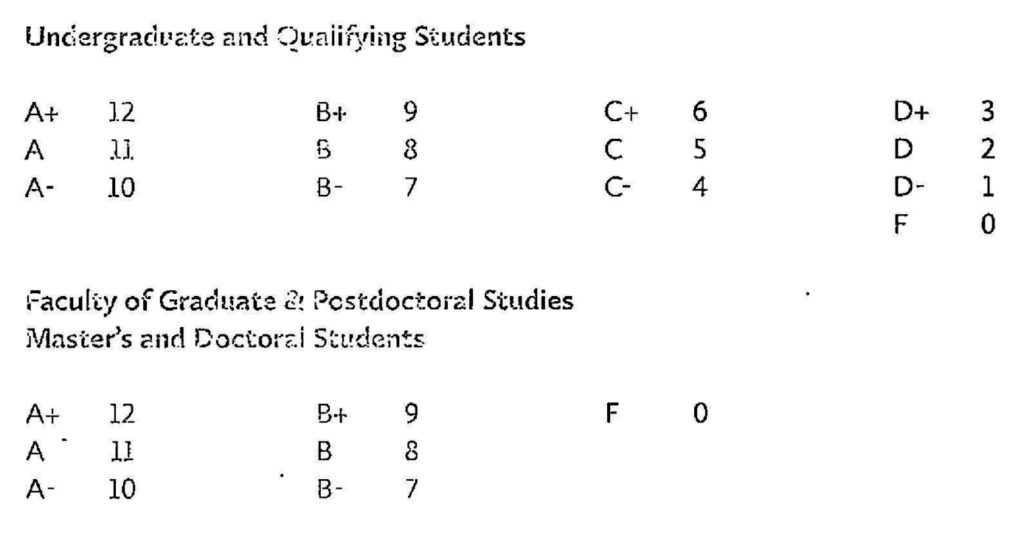
Numerical: French 20-Point Scale
Grading in France is particularly severe.
My colleagues there tell me that it is because everyone who passes that high school leaving exam has the right to go to higher education in public universities. There is no competition to get in to universities. So, the only way they can reduce their student numbers and get rid of the students who have no particular interest or aptitude is by failing them out. It is an achievement just to pass and remain enrolled, and the grading scale below reflects that.
| Grading System: French 20-point Scale | |||||
|---|---|---|---|---|---|
| Local Grade | 20 – 16 | 15 – 12 | 11 | 10 – 9 | 8 – 0 |
| MEXT Grade | 3 | 3 | 2 | 1 | 0 |
| Used in: France | |||||
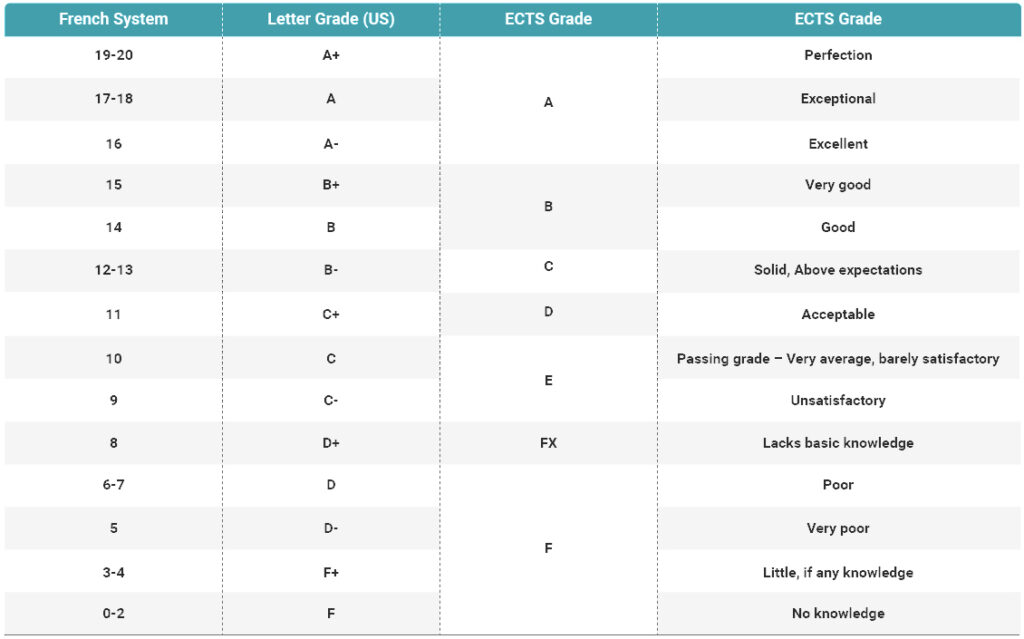
Numerical: Italian 30-Point Scale
The Italian system also has a wide range of grades, but most of the passing grades are concentrated at the top. I have seen many cases where universities did not provide any conversion guidance with their own transcripts, but here is a guide that should work.
| Grading System: Italian 30-point Scale | |||||
|---|---|---|---|---|---|
| Local Grade | 30 lode – 29 | 28 – 25 | 24 – 21 | 20 – 18 | 17 – 0 |
| MEXT Grade | 3 | 3 | 2 | 1 | 0 |
| Used in: Italy | |||||
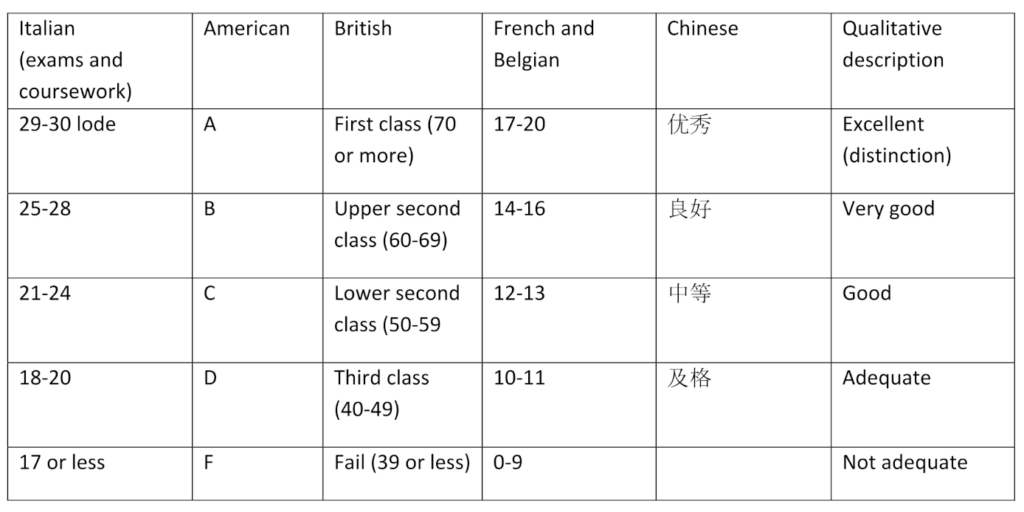
Final thoughts
Remember, the tables above correspond to the images. In most cases, the examples I have provided are consistent within the countries listed, to the best of my knowledge, but if the explanation of the grading system that your university provides is different from what the images above show, then always prioritize the documentation from your university.
Have a system I haven’t covered above?
If your grading system isn’t covered by any of the examples above, submit a scan of the grading system to me via the form below and I will add it to the article above.
https://mymext.com/submitgrades
Note: Since this form includes a file upload option, you must have a google account to use it.

after converting my grade i got B in us grading system which is 2/3 my GPA after conversion in 3.0/4.0 do i have a chance
Hi Lamis,
You need to convert all of your grades one-by-one and then average the converted grade. Converting your overall average can result in an inaccurate number.
A “B” grade in the US system should not be a 2.0/3.0 on the MEXT Scale! In most cases, it should be a 3.0/3.0, so you might want to check your calculations again.
A higher grade is better, but your “chances” depend on so many other factors, including your competition and, depending on what you’re applying for (since you didn’t mention it), your Field of Study and Research Program Plan.
Good Luck!
– Travis
Hi Travis,
My GPA is 2.46 out of 4.00, which is equivalent to 81.8% in percentage. When I converted it to the MEXT scale, it came out to 2.32.
Do you think I should go ahead and apply for the MEXT scholarship?
Hi Arko,
If you’re confident that you converted your GPA correctly and it is above 2.3/3.0, then you should be eligible. I don’t know what your local system is, but I find it surprising that a 2.46/4.00 would convert to an eligible GPA, so you might want to double-check your math. In most 4.0 systems that I am aware of, that would be a C to C+ range grade average. Of course, you cannot convert averages, you have to convert each grade individually, so there might be something I’m missing.
Since your converted GPA is on the lower end of eligibility, it might be a challenge to compete, but you can still try.
Good Luck!
– Travis
Thank you so much for the detailed breakdown!
I calculated my masters from France, and for a 2.28 average. This is below the 2.30/3.00. Should I even bother applying?
Best regards
Faidat.
Hi Faidat,
How confident are you about your grade conversion? Grades translating to 2.28 on MEXT’s scale would be quite low (as in barely passing level), especially for a Master’s degree.
If you barely scraped by in your Master’s degree (i.e. you were at risk of failing) and are sure that your grade conversion is accurate, then it sounds like you would not be qualified. However, it is very common for applicants to misinterpret the grading scale and grade themselves too harshly. So, if you think there is a chance that you may have been too harsh, then you can give it a shot!
Good Luck!
– Travis
Hello Travis,
Thank you for your response.
I achieved a 16.70/20 average, with mostly As and Bs, except for two courses with 2 ECTS credits where I received Es. So my calculation might have been incorrect.
I sent in my application already, that wouldn’t have been possible without all your helpful tips, so thank you so much for that.
My only concern now is that I am applying through my home country’s embassy (Nigeria). However, I have sent in my French Master’s Transcript as is, without an official conversion table, and it doesn’t explicitly say the grading scale applied (i.e out of 20). Would that disqualify my application?
Hi Faidat,
French grading is pretty strict in my experience, so that sounds like an excellent average. Of course, you have to convert grades one-by-one, not the average, but since a 16.7 would be well within the “3” range, I would be surprised if the individual grades converted much lower, even with the Es.
I’m not sure how they will handle the missing grading system in the processing. At my university when I handled applications, we would have told you it was missing and required you to resubmit it (it was very common for applicants to be missing this at the time, or not understand what it meant, so we were used to asking for it), but I don’t know if the embassy will do the same or will handle it in another way. It’s really up to their discretion. I hope they give you a chance!
Good Luck!
– Travis
Hello, Travis,
Thank you very much for your informative blog! I truly appreciate the effort you’ve put into it—it has been incredibly helpful for me.
I have a question regarding GPA in relation to the MEXT scholarship application. Currently, I am pursuing a master’s degree in management, and I plan to apply for the MEXT scholarship in spring 2025. My goal is to pursue a second master’s degree in Japan after receiving the scholarship.
My academic background includes a bachelor’s degree in linguistics and intercultural communication, where my research focused on topics combining business and intercultural communication. I graduated with a perfect GPA of 3.0 out of 3.0. However, my current master’s GPA is not as strong—I have received some D grades.
Given this situation, I am wondering if it would be possible to apply using only my bachelor’s degree and indicate on the application that I am currently completing a master’s program. I would like to highlight that I participated in an exchange program during the first year of my master’s at the University of Tokyo and want to include this in my application. However, I am hesitant to apply using my master’s degree because of my lower GPA.
Could you please advise on whether this approach is acceptable and how I might best present my situation in the application?
Thank you very much for your time and assistance!
Hi Tashi,
Thank you for your kind words!
Unfortunately, you don’t get to choose whether to use your current Master’s degree or not. MEXT requires that you list all current and past degrees in your application and include the applicable records from each. You cannot choose to leave one out and if you try to hide it, that would be considered lying on the application and would get you disqualified if it was discovered.
I’m not sure if it is even possible before the application period starts, but the only option I can see is to do everything you can to earn higher grades throughout the rest of your current Master’s in order to raise your converted GPA.
Good Luck!
– Travis